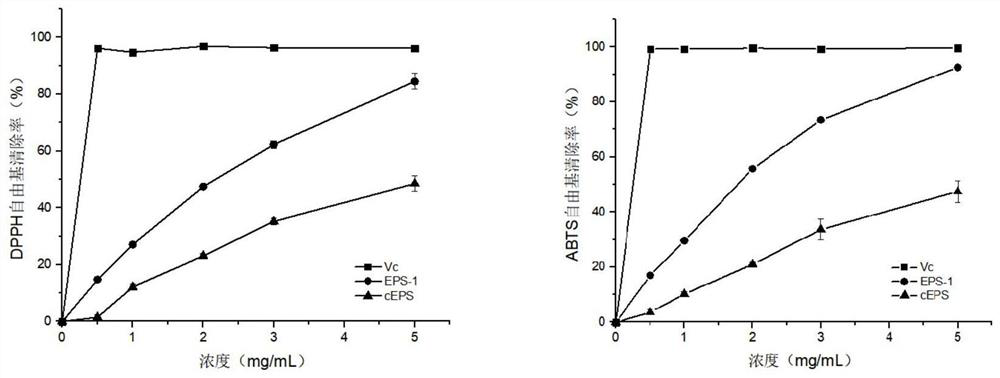Antibacterial lactobacillus curvatus capable of producing exopolysaccharides and application thereof
A technology of Lactobacillus campylobacter and extracellular polysaccharide, applied in the field of microorganisms, can solve problems such as broad-spectrum bacteriostasis and exopolysaccharide that do not involve Lactobacillus campylobacter
- Summary
- Abstract
- Description
- Claims
- Application Information
AI Technical Summary
Problems solved by technology
Method used
Image
Examples
Embodiment 1
[0056] Example 1: Isolation, screening and identification of Lactobacillus curvatus SJTUF 62116
[0057] 1. Isolation of Lactobacillus curvatus SJTUF 62116
[0058] The strain was isolated from naked carp in Qinghai Lake, China. Aseptically collect the viscera of the naked carp and store in a refrigerator at 4°C. Under aseptic conditions, take 5 g of the sample and add it to 45 mL of sterile water, homogenize for 5 min, and then serially dilute (10 -1 -10 -5 ) and shake evenly. Take 100 μL of dilutions of different gradients, spread them on MRS solid medium, and culture them anaerobically at 30°C for 48h. Observe the colonies formed on each plate, pick a single colony to streak on the MRS solid medium plate, and culture anaerobically at 30°C for 48h.
[0059] 2. Screening of Lactobacillus curvatus SJTUF 62116
[0060] Pick a single colony into the MRS liquid medium, and culture it statically at 30°C for 24h. The fermentation broth was centrifuged and filtered with a 0.22...
Embodiment 2
[0069] Example 2: Evaluation of probiotic function of Lactobacillus curvatus (Lactobacillus curvatus) SJTUF 62116
[0070] 1. Evaluation of acid-base adaptability
[0071] The strains were inoculated into MRS liquid medium with a pH of 3.0, 4.0, 9.0 and 10.0, cultured statically at 30°C for 7 days, and MRS liquid medium with the same pH was used as a control, and the results were observed and recorded. The results showed that the strain could grow well under the environment of pH 3.0, 4.0, 9.0 and 10.0, which indicated that it had strong adaptability to acid and alkali.
[0072] 2. Evaluation of adaptability to cold and heat
[0073] The strains were inoculated into MRS liquid medium, cultured statically at 5°C and 10°C for 14 days, and at 45°C and 50°C for 7 days, and MRS liquid medium was used as a control, and the results were observed and recorded. The results showed that the strain could grow well at the temperature of 5°C, 10°C, 45°C and 50°C, which indicated that it h...
Embodiment 3
[0107] Example 3: Extraction and purification of exopolysaccharide from Lactobacillus curvatus SJTUF 62116
[0108] The twice-activated strains were inoculated in MRS liquid medium at 2% (v / v), and cultured statically at 30° C. for 24 hours. The fermented liquid was heated in boiling water for 10 min and then cooled to room temperature. Subsequently, 80% trichloroacetic acid solution was added to a final concentration of 4% (w / v), and stirred at room temperature for 2 h. The supernatant was collected by centrifugation (12 000 g, 15 min, 4° C.), and concentrated under reduced pressure to one-third of the original volume. Add 3 times the volume of absolute ethanol to the concentrated solution, let stand at 4°C for 12h, and then centrifuge (12000g, 20min, 4°C) to collect the precipitate. The precipitate was dissolved in distilled water, concentrated under reduced pressure, and then transferred to a dialysis bag with a molecular weight cut-off of 14KDa for dialysis for 2 days, a...
PUM
| Property | Measurement | Unit |
|---|---|---|
| molecular weight | aaaaa | aaaaa |
| diameter | aaaaa | aaaaa |
Abstract
Description
Claims
Application Information
 Login to View More
Login to View More - R&D
- Intellectual Property
- Life Sciences
- Materials
- Tech Scout
- Unparalleled Data Quality
- Higher Quality Content
- 60% Fewer Hallucinations
Browse by: Latest US Patents, China's latest patents, Technical Efficacy Thesaurus, Application Domain, Technology Topic, Popular Technical Reports.
© 2025 PatSnap. All rights reserved.Legal|Privacy policy|Modern Slavery Act Transparency Statement|Sitemap|About US| Contact US: help@patsnap.com



